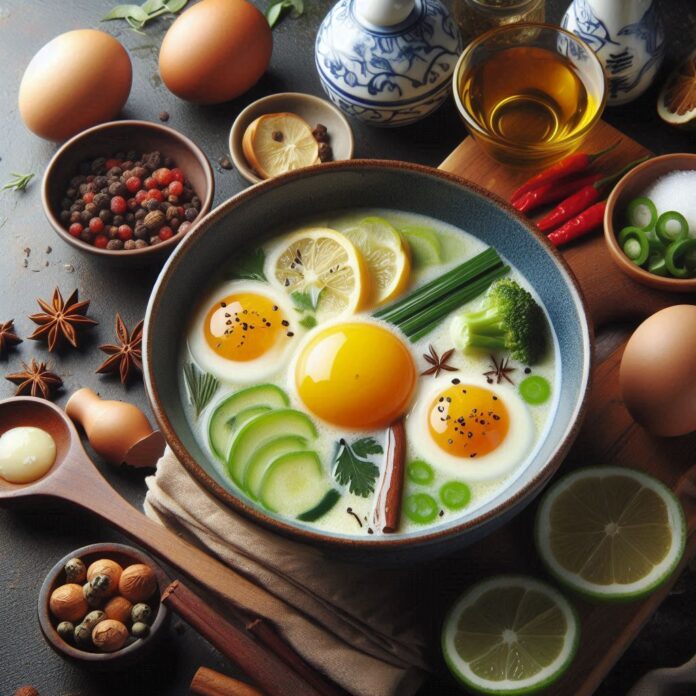Eggs have been a fundamental part of global cuisine for centuries, prepared in countless ways to suit different tastes and cultures. Among the many cooking methods, Century Eggs, Scotch Eggs, and Egg Drop Soup stand out for their unique preparation styles, distinct flavors, and cultural significance. From the ancient preservation techniques of Century Eggs to the crispy delight of Scotch Eggs and the delicate, silky texture of Egg Drop Soup, each style showcases the versatility and richness of egg-based dishes. This article explores their preparation, variations, culinary appeal, and health benefits, revealing why these cooking styles remain beloved worldwide.
I. Century Eggs: Exploring the Unique Egg Cooking Style and Its Timeless Appeal.
Century eggs, a fascinating egg cooking style, undergo a meticulous preservation process that transforms their texture and flavor. This traditional Chinese delicacy is cherished for its rich umami taste and culinary versatility.
-How to Make Century Eggs?
Century eggs are created by encasing duck, chicken, or quail eggs in a mixture of clay, ash, salt, quicklime, and rice hulls. Over weeks or months, the alkaline reaction alters the egg’s composition, resulting in a translucent brown jelly-like white and a dark, creamy yolk with a strong umami profile.
-Variations Of Century Eggs:
While duck eggs are the most common choice, chicken and quail eggs are also used, leading to slight differences in texture and flavor. Regional variations exist, such as Thai-style century eggs infused with tea leaves for an added herbal note.
-How to Perfect Century Eggs?
Achieving the ideal century egg requires precise control over preservation time, temperature, and humidity. Adjusting the salt ratio in the preservation mixture can help balance the firmness of the white and the creaminess of the yolk. The perfect century egg features a glass-like outer layer and a smooth, custard-like yolk with a distinctive aroma.
-Why It’s Popular and Good?
Century eggs are a staple in Chinese cuisine, often served with congee or tofu. Their deep umami flavor and unique texture make them a prized ingredient in both traditional and contemporary dishes. With a long shelf life and complex taste, they continue to be a valued delicacy worldwide.
Century eggs exemplify the art of egg preservation, offering a culinary experience that celebrates tradition and innovation in egg cooking styles.
II. Century Eggs: Health Benefits, Nutritional Value & Culinary Uses.
Century eggs, a traditional Chinese delicacy, offer several unique health benefits due to their preservation process and nutritional profile.
-Rich in Protein and Essential Nutrients:
Century eggs are an excellent source of high-quality protein, essential for muscle development and overall bodily functions. They also provide significant amounts of iron, crucial for oxygen transport in the blood, and vitamin D, supporting bone health and immune function. Additionally, these preserved eggs contain selenium, a potent antioxidant that aids in thyroid function and protects against cellular damage.
-Potential Cardiovascular Benefits:
Studies have indicated that consuming preserved eggs may positively influence lipid metabolism. Research involving rats demonstrated a significant decrease in liver triglycerides and total cholesterol levels after the intake of preserved eggs. These findings suggest potential benefits in managing blood lipid levels, which could contribute to cardiovascular health.
-Anti-Inflammatory and Antioxidant Properties:
Preserved eggs have exhibited anti-inflammatory effects by reducing levels of pro-inflammatory markers such as interleukin-6 (IL-6) and tumor necrosis factor-alpha (TNF-α) in animal studies. The presence of antioxidants, including selenium, further enhances their ability to combat oxidative stress, potentially lowering the risk of chronic diseases associated with inflammation and free radical damage.
-Culinary Versatility and Appetite Stimulation:
Beyond their nutritional advantages, century eggs are celebrated for their unique flavor and texture, making them a versatile ingredient in various dishes. Their distinct taste can stimulate appetite, making them a valuable addition to meals, especially for individuals with diminished appetites.
Incorporating century eggs into a balanced diet can provide these health benefits while offering a unique culinary experience.
III. Scotch Eggs: A Crispy, Savory Egg Cooking Style Loved Worldwide.
Scotch eggs, a beloved British dish, blend the rich flavors of eggs, sausage, and crispy coating into a satisfying bite. Mastering this egg cooking style requires the right technique and variations to suit different tastes.
-How to Make Scotch Eggs?
Scotch eggs are made by wrapping hard- or soft-boiled eggs in seasoned sausage meat, coating them in flour, dipping them in beaten egg, and rolling them in breadcrumbs. The eggs are then deep-fried or baked until golden brown and crispy. The key to perfect Scotch eggs lies in evenly coating the egg and ensuring the sausage layer is not too thick, allowing for even cooking.
-Variations of Scotch Eggs:
While traditional Scotch eggs use pork sausage, variations include chicken, turkey, beef, or even vegetarian options with lentils or cheese. Some recipes add spices like paprika or mustard for extra flavor, and different coatings such as crushed crackers or panko breadcrumbs can provide a unique crunch.
-How to Perfect Scotch Eggs?
Achieving the perfect Scotch egg depends on controlling egg doneness—some prefer a runny yolk, while others opt for a firm center. Ensuring an even sausage layer prevents overcooking or raw spots. Double breading enhances crispiness, and frying at the right temperature (around 350°F/175°C) ensures a golden crust without absorbing excess oil.
-Why It’s Popular and Good?
Scotch eggs are widely loved for their combination of textures—crispy on the outside, savory in the middle, and rich inside. Their convenience makes them a staple for picnics, pub menus, and easy-to-carry snacks. Whether served warm or cold, their versatility and indulgent taste keep them a favorite across generations.
Scotch eggs showcase the artistry of egg cooking styles, offering a satisfying mix of flavor, texture, and tradition.
IV. Scotch Eggs: Nutritional Benefits & Health Considerations:
Scotch eggs, a traditional British dish, consist of a hard-boiled egg encased in sausage meat, coated in breadcrumbs, and typically deep-fried. While they offer certain nutritional benefits, it’s important to consider both their positive attributes and potential drawbacks.
-Nutritional Benefits:
• Protein-Rich: The combination of egg and sausage meat provides a substantial amount of protein, essential for muscle development and tissue repair. A typical Scotch egg contains approximately 12 grams of protein.
• Vitamins and Minerals: Eggs are a notable source of vitamins B2, B12, and D, as well as selenium, which play vital roles in energy metabolism, red blood cell formation, and immune function.
-Considerations:
• Caloric Content: Due to the inclusion of sausage meat and the frying process, Scotch eggs are relatively high in calories. A standard Scotch egg contains about 300 calories, with significant contributions from fat and carbohydrates.
• Fat and Sodium: The sausage meat and frying process contribute to higher levels of saturated fat and sodium, which, if consumed in excess, may impact cardiovascular health.
-Moderation and Preparation:
To enjoy Scotch eggs as part of a balanced diet, consider consuming them in moderation and exploring healthier preparation methods, such as baking instead of frying, to reduce fat content. Additionally, pairing them with fiber-rich vegetables can enhance the nutritional profile of your meal.
In summary, while Scotch eggs provide valuable nutrients like protein and essential vitamins, mindful consumption and preparation are key to incorporating them healthily into your diet.
V. Egg Drop Soup: A Light & Silky Egg Cooking Style with Deep Flavor.
Egg drop soup, a staple in Chinese cuisine, is known for its delicate egg ribbons floating in a flavorful broth. This egg cooking style is simple yet requires precision to achieve the perfect texture.
-How to Make Egg Drop Soup?
Egg drop soup starts with a base of seasoned chicken broth, typically flavored with soy sauce, sesame oil, salt, and white pepper. A cornstarch slurry is added to slightly thicken the soup. Beaten eggs are then poured in a thin stream while stirring gently in a circular motion, creating soft, silky egg ribbons. Once set, the soup is served hot, and garnished with chopped scallions or chives for freshness.
-Variations Of The Egg Drop Soup:
While traditionally minimalist, egg drop soup can be enhanced with additional ingredients. Tomatoes add a tangy twist, spinach or shiitake mushrooms bring depth, and tofu or shredded chicken make it heartier. Some variations also include sweet corn for a hint of natural sweetness. These additions allow for a personalized take on this classic dish.
-How to Perfect Egg Drop Soup?
The key to a perfect egg drop soup lies in the egg-pouring technique and temperature control. Eggs should be drizzled in slowly while stirring gently to form delicate, uniform strands. Over-stirring can break the ribbons, while high-quality homemade broth elevates the overall flavor. Adjusting seasonings like white pepper or sesame oil can fine-tune the taste to preference.
-Why It’s Popular and Good?
Egg drop soup is beloved for its simplicity, quick preparation, and comforting warmth. Commonly served as a starter in Chinese restaurants, it is also a favorite homemade dish due to its versatility. Its light yet flavorful profile makes it an excellent accompaniment to various main courses. The ability to adapt the recipe to different tastes further contributes to its worldwide popularity.
Egg drop soup exemplifies the beauty of egg cooking styles, offering a perfect balance of simplicity, technique, and taste.
VI. Egg Drop Soup: Health Benefits & Nutritional Value of This Classic Dish:
Egg drop soup, a staple in Chinese cuisine, offers several health benefits due to its nutritious ingredients and preparation method.
-Low in Calories:
A standard serving of egg drop soup contains approximately 66 calories per 244-gram serving, making it a suitable option for those monitoring their calorie intake.
-Protein Content:
The inclusion of eggs provides a source of protein, essential for muscle maintenance and overall bodily functions. While the protein content may vary based on the recipe, eggs contribute to the nutritional value of the soup.
-Rich in Vitamins and Minerals:
Egg drop soup contains vitamins such as vitamin A and vitamin C, as well as minerals like iron and calcium, contributing to various bodily functions and overall health.
-Digestive Benefits:
When prepared with ingredients like ginger and turmeric, egg drop soup may aid digestion and provide anti-inflammatory benefits. These additions can help soothe the digestive system and alleviate discomfort.
-Hydration and Satiety:
As a broth-based dish, egg drop soup contributes to daily fluid intake, promoting hydration. Its warm, liquid nature can also create a sense of fullness, which may aid in appetite control.
Incorporating egg drop soup into a balanced diet can provide these health benefits while offering a comforting and flavorful meal option.
Conclusion:
Eggs continue to be a staple ingredient in diverse culinary traditions, offering both exceptional taste and valuable nutrition. Whether it’s the umami depth of Century Eggs, the savory crispiness of Scotch Eggs, or the comforting warmth of Egg Drop Soup, each cooking style reflects a unique blend of history, technique, and flavor. Beyond their delicious appeal, these egg-based dishes provide essential nutrients, protein, and potential health benefits, making them an integral part of a well-balanced diet. By appreciating these time-honored cooking styles, we celebrate the artistry and innovation that eggs bring to the culinary world.

